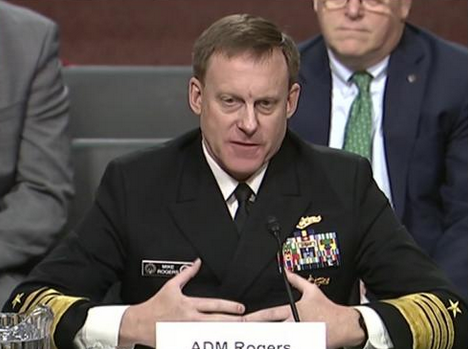
US Cyber Command boss Navy Adm. Mike Rogers testified before the Senate Armed Services Committee Tuesday. Screenshot photo.
The commander of the US Cyber Command, Navy Adm. Mike Rogers, Tuesday painted a mixed picture of progress on cyber concerns in testimony before the Senate Armed Services Committee.
Rogers comments came two days before the panel is set to consider the nomination of Army Lt. Gen. Paul Nakasone, current head of US Army Cyber Command, to succeed him in the post, which he’s held since 2014.
In his testimony, Rogers pointed to progress on protecting the critical US infrastructure, saying there has been “greater recognition” of the problem, but the response to the threat is still “uneven.” Though he said some segments are “very advanced” and “doing some great work … other segments, not so much.”
On another key area, data manipulation, he said the situation “has gotten worse.” The reason is “now you’ve got a major actor, and they’re not the only ones, in the form of the Russians,” who acknowledge it as a conscious part of their strategy, added Rogers.
Progress on another major threat, nonstate actors, he said, “surprised me a little bit” in that, other than criminal elements, “that has not taken off quite as much as I thought it would.”
He pointed to a number of accomplishments in his time as head of the command, including the Cyber Command’s integration with other operational commands, particularly US Central Command, Special Operations Command, and some Pacific Command activities; as well as some of the command and control structures and joint task force areas instituted. “It was a slow start because we were starting from Ground Zero, but it has really taken off,” he said.
Areas that he would like to have gotten further, include tool and capability development and working out the respective roles of the services and the command in the cyber area.
Looking toward the future, he told the panel he would advise his successor that the US cyber structure needs to be revised. The current structure, he said, “reflects choices we made eight to 10 years ago,” and officials must examine how to consider the lessons of the last eight years when there has been substantial cyber activity on the defensive and offensive side, including work with the private sector.
“There are insights there that I think we can harness” to look at how to modify the current structure, said Rogers.
In addition, he said, the Defense Department’s role in relation to defense contractors needs to be improved. “We’ve got to get a different dynamic here. We’ve got to look at that differently.”
Also, he said, it is important to figure out how Cyber Command can work with other entities in a “much more integrated way.”